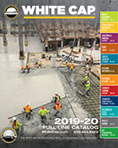Choosing Building Materials: Is your vapor barrier choice eroding profits?
Choosing Building Supplies and Installing a Vapor Barrier
Contractors play the main role in delivering high-performance concrete floors.
Their team turns floor details into plans and follows an assurance program to make sure floor systems and building materials meet design requirements.
Frequently, requirements include mitigating vapor transfer from the subgrade with an under-slab barrier. Shrewd contractors look for building materials that are approved vapor barriers (many design professionals use the terms vapor barrier and vapor retarder interchangeably) that are proven, durable and more cost-efficient to maximize their profits.
Engineers often choose a project’s vapor barrier, and they use a broad set of building code guidelines to select the best one. They consult with architects and owner about the building’s potential use and flooring surface treatment. Then soil type, sub-base characteristics and drainage are all considered before a vapor barrier class and thickness recommendation if provided.
Engineers typically select the vapor barrier, but that shouldn’t limit manufacturer choice.
Contractors can propose less expensive equivalent alternatives to the named manufacturer by checking with an White Cap Product Specialist to review their options on each project. White Cap has building materials for every job and performance requirement. They’re made in the USA and tested by third party labs to guarantee high-quality installation and performance.
Make sure the selection process works for you.
Many contractors don’t clearly understand the vapor barrier selection process.
You can compare a contractor’s relationship with decision makers to the parties that decide how Major League Baseball is played. MLB rules govern games – standardized scoring, protocol and procedures – but home teams can still alter field layout. Rules regarding tools of the game like bats, gloves and bases remain the same, but they’re supplied by several manufacturers that conform to MLB rules. This process ensures tool performance fairness while allowing players to choose brands they prefer.
Contractors involved early in the selection of building materials can create their own home field advantage.
In concrete floor design and installation, the rule book for building officials, architects and owners is the American Concrete Institute’s Guide to Floor and Slab Construction. It outlines the industry consensus for vapor barrier use.
And like the MLB rulebook, it allows some wiggle room to alter procedures for some projects. The ACI encourages designers and contractors to use only products conforming to ASTM International standards. They can use these standards to compare vapor barrier products and find an alternative equivalent or better material that might save money. White Cap Product Specialists can be a big help in this effort.
What makes vapor barrier selection confusing?
Many designers view vapor barriers as a commodity, not an engineered product.
This misconception can be traced to a 1950’s product used in concrete floor construction. These early barriers were 6-mil polyethylene sheets sold by British Polythene Industries Limited under the trademarked name Visqueen. They were marketed as a versatile building material useful for many other different construction applications like temporary tarpaulins, drop cloths and weed barriers.
Building owners soon found that using 6-mil plastic sheeting under concrete slabs was seldom effective. Visqueen is water-tight, but smaller water vapor particles pass through. And it often gets punctured, stretched or torn during concrete placement leaving openings that can let a lot of water vapor into the slab. By the 1960’s, researchers like H. W. Brewer were finding ways to improve vapor barriers.
What is perm performance?
Contractors now have vapor barriers designed to almost eliminate vapor transfer.
Today’s materials conform to the requirements of ASTM E-1745, Standard Specification for Water Vapor Retarders Used in Contact with Soil or Granular Fill under Concrete Slabs. Modern polyethylene particles are much denser to resist tears or punctures – and it’s inert too, maintaining its physical properties for decades. And most importantly for a contractor’s bottom line, polyethylene is one of the most economical plastics available.
But vapor retarders don’t seal all moisture out of a slab – they reduce the permeation rate. Vapor barriers are given a perm (permeability) rating that indicates how much water vapor passes through over a designated amount of time. Manufacturers use one of two test methods to determine their product’s perm rating – ASTM E96/ E96M or ASTM F1249.
ASTM E-1745 defines an A, B and C Class of vapor retarders and most building codes use these classifications. The lower the perm rate, the better for slabs. Class A has the lowest perm rate while Class B (from 1 to 10 perms) and Class C (greater than 10 perms) allow higher perm rates. The US Department of Energy recognizes all three, but advises contractors and their clients to use Class A if possible.
Mitigating vapor goes beyond fabric sections. Researchers looked for way to keep it from entering the slab edges when placed on the subgrade. Contractors are required to overlap seams by at least six inches. The seams should then be sealed with vapor-barrier-approved tape. Code officials and engineers reference ASTM E1643.
The perm number isn’t all that matters.
Engineers focus on a barrier’s lifespan, but contractors need an installation-friendly material.
The wrong vapor barrier material can be a nightmare to install. It must be resistant to stretching, tearing, punctures and remain flexible enough to handle easily. Using the appropriate vapor barrier is even more important when inspectors require installation and approval prior to concrete placement.
A pre-installed surface can be problematic for contractors using buggy or pump placement – especially when a laser screed will travel on the slab. Power buggies moving concrete from truck chute to placement point are the biggest challenge, so contractors often go with thicker vapor barriers to prevent punctures. And when concrete is placed by pump, a thicker fabric can prevent punctures from the concrete’s weight – especially when the sub-base consists of large, angular aggregates like recycled concrete. Puncture is also a concern when plastic chairs are used to support reinforcement.
But don’t forget about fabric flexibility. It’s a big plus on projects where vapor barrier installation is allowed during concrete placement. Installers often add lengths that correspond to laser screed reach, so the fabric needs to be flexible, foldable and tear resistant – but easy to slice. Crews frequently make adjustments and trim edges for better overlaps just prior to placement.
The raw materials used to make the fabric matters too. Contractors should look for products made with pure-grade, polyethylene resins with no recycled content. Vapor barriers made with polyethylene have high tensile strengths, puncture and tear resistance and low perm rate compared to other polymers.
Choose a building materials with a good quality control program during and after processing.
Raw materials including resins and additives should be tested for quality and eligibility in the manufacturer’s laboratory and the extrusion process should be carefully monitored for adherence to operational requirements. After production, samples should be tested for specified thickness, tensile strength and puncture resistance by third party labs. For more information, view online catalog of building materials here.





